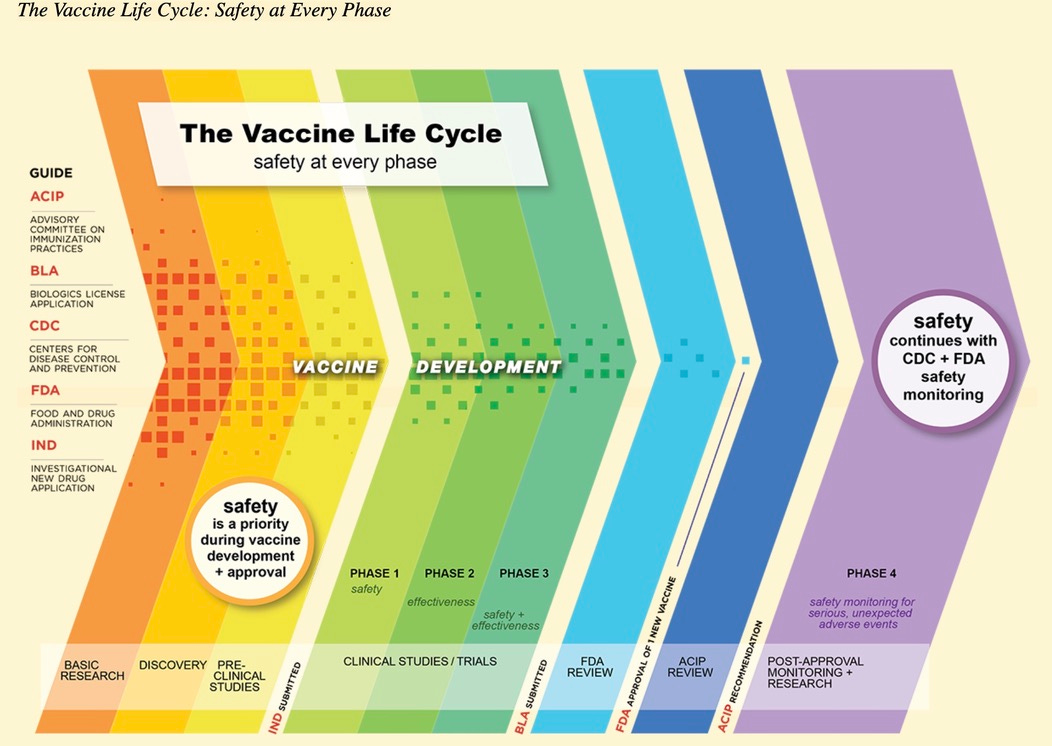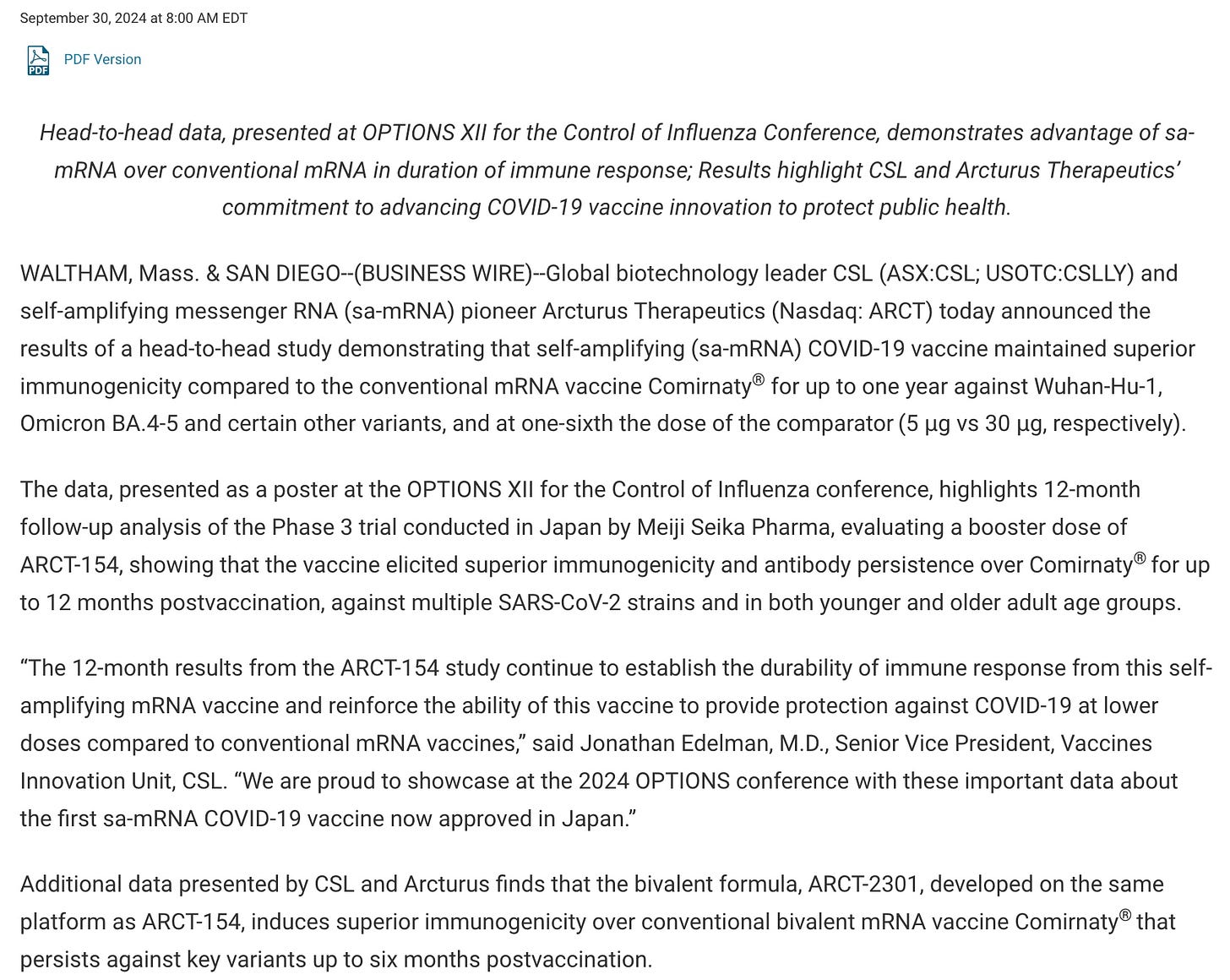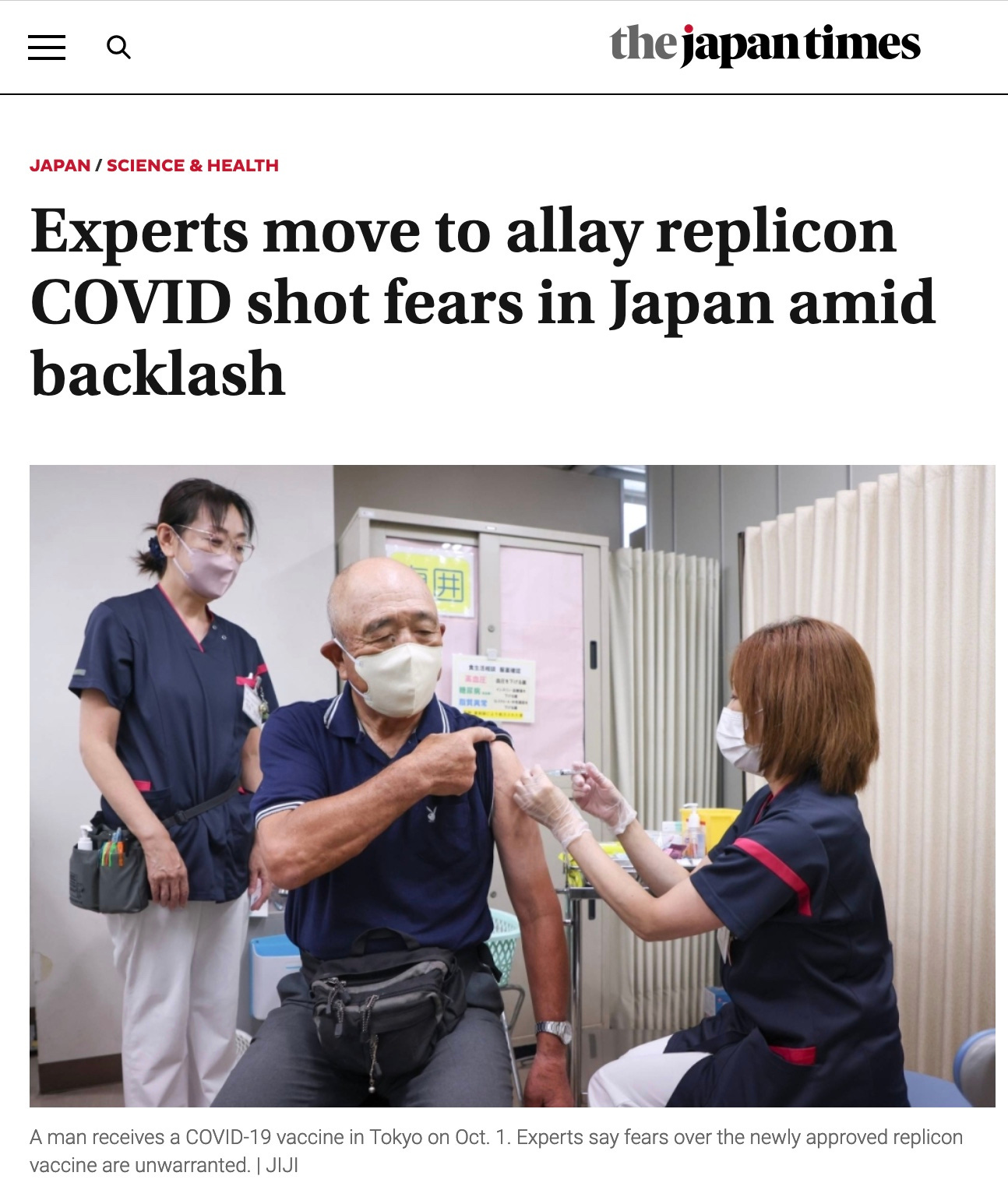Self-amplifying mRNA vaccines
2 gutsy companies (Arcturus and CSL) test drive their first-in-class vaccine in Japan--and how this ties in with the 100 day vaccine promise of CEPI and the globalists
Bottom line: there are no long-term data on these vaccines. And since they might produce the spike protein, an indisputably dangerous toxin, indefinitely, it would be crazy to use this vaccine. But since the era of COVID began, the precautionary principle was thrown out, and the more risks a vaccine manufacturer and regulator take, the better, it seems.
Here is what the manufacturer Arcturus claims as the benefits of this vaccine:
it requires a much lower dose for the same degree of antibody production
it continues to induce the production of more antigen (spike protein) for a longer duration than existing mRNA vaccines like Comirnaty
I have long explained (for 25 plus years) that vaccines are unsuitable as a response to bioterrorism (or for that matter, rapidly mutating viruses) because you don’t know what the infectious agent will look like ahead of time, nor what the immunogenic epitopes on it will be—the area(s) against which a vaccine is directed. So you can’t design a vaccine ahead of time.
Furthermore, it takes years to assess the safety, efficacy and proper dose of a vaccine. So by the time you have been able to prepare and manufacture a vaccine the pandemic or biowarfare epidemic has come and gone.
Below is a [pre-COVID] CDC chart designed to show what happens during the 10-15 years it takes to develop a vaccine. Most vaccine candidates never make it to licensure because they are not safe or effective or require too high a dose to be economic.
Instead of admitting that producing a vaccine in time for an epidemic or biowarfare is impossible, grifters like Jeremy Farrar and Bill Gates, who together created the financial black hole CEPI (Coalition for Epidemic Preparedness Innovation) in 2017 to siphon $billions of our tax dollars for the 100 day vaccine moonshot, have simply behaved as if the limits of scientific innovation don’t apply to them.
They did not start with a new scientific advance. No, they started with a preposterous claim: We WILL produce a vaccine for pandemics or biowarfare in 100 days. And we will manufacture enough for the entire world in 30 more days.
How do you make this work? There is no new science. You make it work by killing regulation. Killing regulation works if you don’t actually care whether your product works or is safe. The original COVID vaccines seem to have been the test of whether you could make unsafe and ineffective vaccines and convince the public to take them.
Check.
But it took over 300 days to roll out the first Pfizer vaccines. So you need to use a platform that requires a smaller amount of product. The self-amplifying vaccine does that. That speeds up the manufacturing considerably.
If you can kill off a real regulatory process, you probably can manufacture enough of the self-amplifying vaccine for the whole world in 30 days. And you may make CEPI’s vaccine promise a reality.
You demand that every nation create a clinical trials network—the WHO and UN treaties attempted to include this but did not get the language to do so over the finish line. Ezekiel Emanuel has claimed it was a citizen duty to participate in clinical trials! And the 2016 21st Century Cures Act instructed FDA to use existing big data instead of clinical trials to speed up drug and vaccine licensure. In other words, the globalists have long viewed the traditional clinical trial process as a problem and tried to come up with ways to get around it.
What really happened for both the older COVID vaccines and the self-amplifying COVID vaccines (which Pfizer was studying in 2020 btw) is that very brief clinical trials were conducted, insufficient to generate evidence of safety or efficacy. Even then, Pfizer massaged its data, losing a huge number of vaccinated subjects but very few placebo subjects and mischaracterizing deaths and adverse events. Comirnaty’s clinical trial allegedly enrolled 40,000 subjects, but the data used by FDA to issue an authorization came from a mean enrollment of only two months.
The duration of enrollment for the Vietnam study of the self-amplifying mRNA vaccine was “up to three months” and averaged one month of followup after the first dose:
The placebo groups in 2 studies described in the paper above (one a pooled study of 1,000 subjects and the other a study of 16,000 subjects) allegedly had many more serious adverse events than the vaccinated subjects: 3.3 times as many in the first group, and 1.6 times as many in the second group. This reveals some significant problem with the study: perhaps the placebo injection caused problems, perhaps the placebo groups were sicker than the vaccinated groups, perhaps the investigators favored the vaccine groups and did not list all their adverse events… Whatever it was, this told me the study was unreliable and should not be considered in a licensing decision. The claim was made that the vaccine was 56% effective.
What about Arcturus? On its Board is the famous or infamous Dr. Moncef Slaoui, who was the Chief Scientific Advisor to Operation Warp Speed. He has been involved with a number of questionable vaccines it seems:
Under his leadership the operation enabled the fastest ever development, manufacturing, and approval of multiple COVID-19 vaccines in less than 11 months after the virus genetic sequence was described. Dr. Slaoui has sat on several biotechnology company boards, including Moderna, Inc. and Lonza Group AG, and he chaired the boards of Galvani, and Vaxcyte, a vaccine development platform company. Dr. Slaoui spent nearly 30 years at GlaxoSmithKline (GSK) holding leadership positions including as member of the Board of Directors of GSK PLC; Chairman of Pharmaceutical R&D; Chairman Global R&D, Vaccines & Oncology; and Chairman, Global Vaccines. As Chairman of Pharmaceutical R&D, Dr. Slaoui led a restructuring to improve focus on innovation and productivity. As Chairman of Global Vaccines, Dr. Slaoui was directly involved in GSK's vaccine pipeline, leading to the creation of 14 new vaccines, including Shingrix®, to prevent shingles; Cervarix®, to prevent cervical cancer; Mosquirix, to prevent malaria; Rotarix®, to prevent rotavirus gastroenteritis; and Synflorix, to prevent pneumococcal disease.
Arcturus just produced some longer-term, additional data about its vaccine:
What is the bottom line?
The spike protein should not be used as an antigen for any vaccine due to its toxicity—but it is being used again, regardless.
The LNP in this case has been around a long time and probably has roughly similar toxicity as the Pfizer and Moderna LNPs.
Current mRNA COVID vaccines have net no efficacy (since their initial efficacy becomes negative after several weeks or months) and so a prolonged duration of spike protein production could mean even worse (more negative) efficacy—which should be settled before giving the vaccine to people.
In Japan, there is concern that the vaccine could spread or shed between people. Certainly, since this self-amplifying vaccine makes its own mRNA, this is a greater concern than with ordinary mRNA vaccines. Greater amounts of mRNA might be found in body fluids (including exosomes) or breath or excreted with urine and stool. Will the replicase enzyme (the rna dependent RNA polymerase) also be produced in large quantities? I do not know.
Japan is a country where there is a lot of knowledge about the risks of the mRNA vaccines. It appears that the new sa-mRNA vaccines, which rolled out at the start of October in Japan, are getting push-back from the people.
A new COVID-19 vaccine has sparked extreme anxiety among parts of the public, leading some businesses to deny services to those who have received the shot and causing at least one clinic to stop giving the vaccine for fear of being harassed.
The health ministry and experts say such fears — fueled by comments circulated both online and offline that the vaccine multiplies in the body indefinitely and as a result causes the “shedding” of its ingredients from an inoculated person to unvaccinated individuals — are unwarranted.
“There’s no scientific evidence that the replicon vaccine will make an infinite number of proteins in the body or its components will be transmitted to others,” the health ministry states on its website.
One of the five shots included in the government’s routine COVID-19 vaccination program, which began Oct. 1 and runs until the end of March, is the replicon vaccine Kostaive. Once inside the body, it uses a self-amplifying messenger RNA that creates proteins evoking immune responses against the coronavirus.
U.S.-based Arcturus Therapeutics developed Kostaive to address the shortcomings of earlier mRNA vaccines, which can only keep infection or the development of symptoms at bay for a few months.
The vaccine can evoke a stronger and more sustained immune response using a smaller dose than conventional mRNA vaccines, according to Meiji Seika Pharma, which manufactures and markets the shot in Japan.
In the last stage of a clinical trial using the vaccine as the initial shot, which was conducted in Vietnam during a delta variant wave and involving 16,000 people, Kostaive was shown to prevent the development of severe illness in 95.3% of those who received it while preventing symptoms from emerging in 56.6% of recipients.
In a separate trial for a booster shot comparing Kostaive and Pfizer’s Cominarty shot involving 828 people in Japan, the former was shown to sustain higher levels of antibodies, with comparable levels of side effects that were either minor or mild, according to data provided to the health ministry.
Japan was the first country to approve this “next-generation” mRNA vaccine, while the European Medicines Agency is currently reviewing Arcturus’ request for the vaccine’s approval in the European Union.
In Japan, fears about the vaccine’s safety have spiraled. In August, the Japan Nursing Ethics Association, a group of nursing ethics researchers, released a statement questioning the vaccine’s safety. The statement referred to the danger of vaccine shedding from the inoculated to the unvaccinated, quoting a paper published in a U.S. journal largely known for its opposition to vaccines.
The panic over shedding escalated last week, when the major yoga chain Lava announced an entry ban for those who have received this replicon vaccine “until its safety is confirmed.” Lava runs over 500 yoga studios across Japan.
One clinic in Tokyo’s Kita Ward even suspended reservations for the vaccine after it was inundated with threats and harassment from those protesting against the replicon vaccine.
“It has become difficult to respond to reservation inquiries about the world's first replicon vaccine,” the clinic, run by Dr. Hiromichi Ito, wrote on its website. “While we believe that the theoretical and scientific data (on the vaccine’s safety) are acceptable, the public opposition has been so extreme. We have received threats and slander on social media and harassing phone calls even late at night.”
Yuji Yamada, assistant professor of geriatrics at the Icahn School of Medicine at Mount Sinai in New York, called the nursing ethics association’s statement “pretty horrible,” saying it was given a false sense of authority by quoting a paper that may look reputable to some but which is scientifically flawed.
“The statement cites a paper in which the authors imagine that shedding could occur with this vaccine and say that there is concern about shedding, but in reality, there is no paper that has proven shedding at all.”
The word “shedding” is often used to refer to the transmission of a virus to humans through saliva or droplets after the virus replicates in the body. Yamada says there is no possibility of Kostaive causing the virus to be transmitted.
“This vaccine only contains mRNA that produces spike proteins, so it is impossible to create a complete virus,” he said.
In addition, mRNA easily breaks down in cells, so even if the vaccine’s mRNA lasts longer than other mRNA shots, it won’t keep multiplying forever, he said. Meiji Seika Pharma says the amplification period is short, noting that animal studies have shown significantly fewer mRNA at the injection site eight days after inoculation.
But some doctors have, for now, stopped short of actively recommending the replicon vaccine, given the abundance of other mRNA vaccines that have been used around the world and whose safety has been well established.
Yamada added that, in general, the use of the self-amplifying vaccine is not advisable for people taking immunosuppressants and pregnant women, as clinical studies have so far excluded them.
“It’s just that the data (involving these groups of people) aren’t fully there yet for the vaccine, so I would recommend other options,” he said.
Setting aside safety concerns, Kostaive won’t probably be widely available this year anyway, Yamada said, noting that small clinics administering COVID-19 shots are shying away from stocking the vaccine for financial reasons.
As one vial of Kostaive contains 16 doses, some clinics are worried about the prospect of not using up all the doses within one month, the period during which an unsealed vial can be kept, he said. If they do not use up their doses, the clinics could lose money.
Until April, COVID-19 vaccinations were classified as temporary inoculations and offered for free, with the central government paying the full cost. Since this month, COVID-19 shots have been administered as part of an annual routine inoculation program similar to seasonal flu shots.
COVID-19 shots are recommended for people age 65 or older and those between the ages of 60 and 64 with severe underlying conditions. The health ministry subsidizes the shots to cap out-of-pocket expenses at ¥7,000 ($47), and some municipalities offer subsidies to bring the fee down or offer them for free.











"Killing regulation works if you don’t actually care whether your product works or is safe."
But they knew it works. It works to kill.
Vaccine hostility as an alternative to both vaccine hesitancy and vaccine confidence.
A short timeline of Congressional acts and appropriations demonstrating federal government intent to harm and kill with legal impunity using 'vaccines,' and effective execution of programs.
https://bailiwicknews.substack.com/p/vaccine-hostility-as-an-alternative
They were touting these at the beginning of COVID and then things got very quiet. I suspect this may be what was deployed anyway, and that's why there was so much apparent shedding.
My notes on the subject:
CEO in May 2020
https://www.youtube.com/watch?v=YQhllSiZr8o
This was their CEO promoting their product in September 2020.
https://www.youtube.com/watch?v=I49f2-07Hzg
With only six likes and comments turned off, you can see why this never got promoted in the west. Doesn’t mean it wasn’t doled out though.
It now comes in a powdered form that is “very stable”
https://www.youtube.com/watch?v=MbuNz_bwDpQ
Precision Nanosystems (Gates-funded: https://www.gatesfoundation.org/about/committed-grants/2020/11/inv023637)
The new generation of RNA vaccines that require ultra-low doses & help ramp up production
https://www.youtube.com/watch?v=ZoCyoZ40tQ4
Oh, splendid. At around 5 minutes and change, she says one of the big institutions working on this is Imperial College, London
“There team got access on the 20th of January last year [2020], and then within a month, they were able to confirm self-amplifying RNA expression, and they started immunogenicity studies”
PrecisionNanosSystems: Self Amplifying mRNA vaccine for COVID 19 Dr. Anna Blakney Imperial College May 2020
https://www.youtube.com/watch?v=tVh1s06H_nw
~4:30 admits replicating vaccines are the least safe
~15 min “so, knowing this, we then start the outbreak”
~16:11 timeline https://www.youtube.com/watch?v=tVh1s06H_nw&t=971s
They already had self-amplifying RNA confirmed by Feb 12, 2020
“This is quite a rapid timeline for making these vaccines, which I think is one of the advantages of self-replicating mRNA”
~27 min “we don’t need a whole manufacturing facility; with the appropriate amount of money, I can make a million doses in the lab”
~30 min Imperial College and PrecisionNanoSystems
More:
https://www.youtube.com/watch?v=p-9Z0MhcCVM
~1 min “this work was conducted from 2008-2015… all the data…during the time”
^^Holy crap. This is old tech.
More:
https://www.youtube.com/watch?v=Wj2u-mA0szU
Terrifyingly, these really are room temperature stable
https://www.nature.com/articles/s41541-022-00549-y